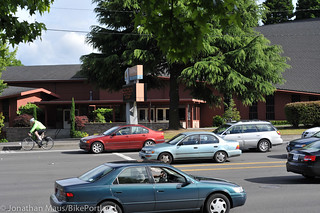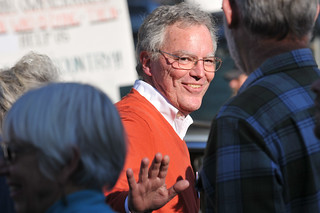An anti-transit vote in Tigard Tuesday could bite bike plans, too.
When Tigard voters narrowly approved a ballot issue this week designed to make it harder to build a light rail or rapid bus line through their city, they also threw a wrench in a different process: improving biking in the suburbs southwest of Portland.
Metro’s Southwest Corridor Plan, a 20-year effort to expand high-capacity transit down the Barbur Boulevard corridor potentially as far as Sherwood, has also been seen as a way to get state and federal funding for a related project: a flat, comfortable bike route through the area such as a physically protected bike lane on Barbur Boulevard.
As people who bike on Barbur Boulevard (or who would like to) have called for improvements to biking on the street, the state Department of Transportation has responded many times that major improvements would have to wait until the Southwest Corridor process was completed. Some have even speculated that the state’s rationale for not removing a northbound lane from part of Barbur, even though the effect on Barbur’s capacity would be negligible, was to avoid giving more ammunition to light-rail opponents who’ve warned of “Portland creep” that would make car transportation less convenient.
On Tuesday, those light rail opponents won in any case. So what now?
Metro Councilor Bob Stacey said Thursday that first of all, this week’s vote hasn’t derailed the potential for better transit through Tigard.
“I don’t see necessarily a big zig or zag here,” Stacey said in an interview.
Stacey said that the most important new measure required by Tigard’s initiative — a public vote to approve ordinances related to the siting of a high capacity transit route — is something that could be accomplished on the same ballot as a measure to raise money for such projects.
“A vote is likely in all of our futures to the extent that existing community revenue isn’t sufficient to put together the regional and federal match for a project,” Stacey said. “Not only Tigard voters, but other voters in the region, may face a choice on how we fund this, or our share of it.”
In other words, the “voter approval” now required by the Tigard ballot initiative might include a vote by all Washington County residents, or all Metro area residents, for a whole basket of transportation improvements.
As for the ballot measure’s requirement that Tigard send a letter to the state, regional and federal governments saying that it opposes any high-capacity transit projects that would reduce “road capacity” in or around Tigard, Stacey said the will of Tigard’s voters doesn’t seem to require Tigard officials (such as Mayor John Cook, who supports the Southwest Corridor plan) to withhold their input on such projects.
“I hope that Tigard officials will be encouraged to keep going in order to carefully implement the will of the people, in order that they be carefully consulted,” Stacey said. “I think this project needs the participation of every local government and as many community members as possible in the corridor to be effective. We’re not going to do that if we don’t have the City of Tigard at the table.”
Tigard’s city council is meeting on Tuesday to discuss how the city government should respond to the ballot issue’s success.
Still, Stacey said Tuesday’s vote might indeed make it harder to find money for major bike improvements in the Barbur Boulevard area.
“If we’re not going to have a federal project with a federal match, it’ll be harder to get those projects that we take forward as priorities funded,” he said.
But Stacey said he expects the Southwest Corridor process to continue, and said there’s a “very high probability” that it will include major biking improvements.
“When you have a route like Barbur, which has a grade that’s not even challenging to me at age 64, it’s a wonderful opportunity to make it better and safer,” Stacey said. “There’s a widespread understanding at the local government level, in the neighborhoods, at least as far as the county line, that safe bicycling is an essential part of mobility and livability. It’s a great way to get to transit.”



